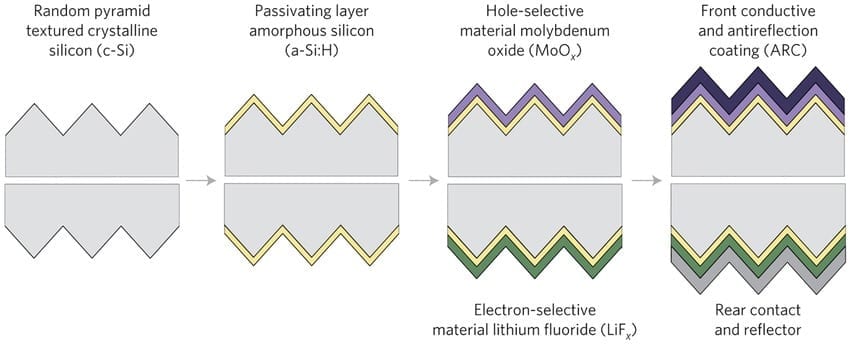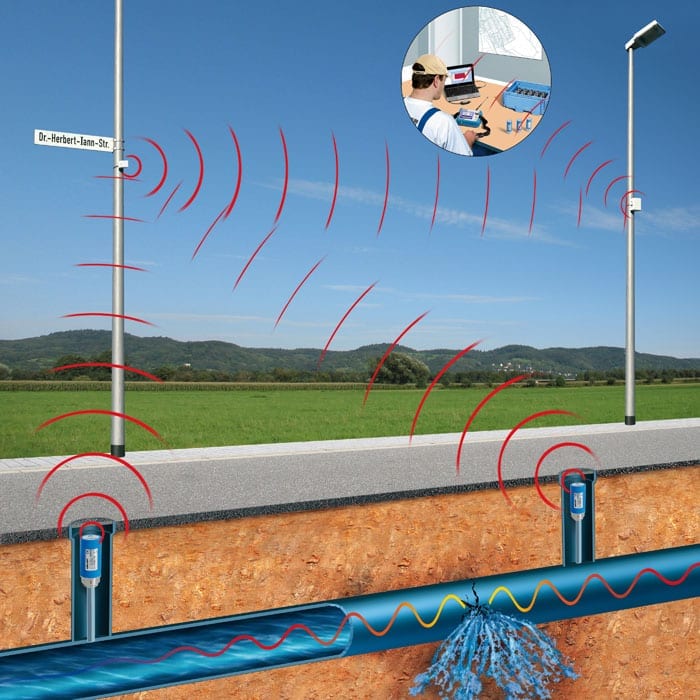
A simplified architecture leads to efficiencies rivaling conventional silicon solar cells.
The Science
A new architecture takes very few processing steps to produce an affordable solar cell with efficiencies comparable to conventional silicon solar cells. This new architecture uses alternative, transparent materials that can be deposited at room temperature, eliminating the need for high temperature chemical doping—the process currently used to increase the electrical conductivity of key surfaces in solar cells.
The Impact
Proving that this simple design can lead to high conversion efficiencies, turning sunlight into electricity, makes it a useful tool to lower costs and improve performance of a wide range of solar cell designs. Additionally, this simple process could be extended to improve contacts in semiconductor transistors used to speed today’s computers.
Summary
In this simplified architecture, sunlight passes through the top layer (metal oxide) and creates electron-hole pairs in the silicon. The holes are drawn to the molybdenum oxide layer, while the electrons are drawn to the lithium fluoride layer, which can be used to produce electricity. This design uses a seven-step process and low-temperature processing to produce a device that efficiently separates photo-generated elections and holes. In this process, the crystalline silicon with a pyramid texture is coated with a passivating layer of amorphous silicon. Then, molybdenum oxide is deposited at room temperature on the top side of the device.
Molybdenum oxide advantageously is transparent, allowing the sunlight to reach the silicon core, and has the appropriate electronic properties to conduct the photo-generated holes. Next, lithium fluoride is deposited at room temperature onto the bottom side of the solar cell to draw the photo-generated electrons from the silicon core. This simple, processing is less expensive than conventional processing for silicon solar cells that requires chemical doping at high temperatures to create contacts that separate the photo-generated electrons and holes. Impressively, the simplified architecture achieves solar energy conversion comparable to conventional silicon solar cells at a lower cost.
Learn more: Keep it Simple: Low-Cost Solar Power
The Latest on: Low-Cost Solar Power
[google_news title=”” keyword=”Low-Cost Solar Power” num_posts=”10″ blurb_length=”0″ show_thumb=”left”]
via Google News
The Latest on: Low-Cost Solar Power
- Making Solar Affordable: This $7 Billion US Investment Expands Solar For Allon April 26, 2024 at 11:19 am
New grants for Solar for All programs aim to install solar panels and boost community solar access for over 900,000 low- and middle-income residents nationwide.
- Is solar worth it in Nevada?on April 26, 2024 at 3:38 am
Average solar panel costs in Nevada are relatively low compared with other states. Before the federal solar investment tax credit (ITC), a typical residential system ranges from $12,923 to $25,846.
- California-based solar-power firm cutting 1,000 workerson April 24, 2024 at 1:08 pm
SunPower Corp. will eliminate more than 25% of its workforce as the company copes with a prolonged slump in the rooftop solar business. San Jose-based SunPower will cut about 1,000 out of a total of ...
- The US is preparing to hit back at China's glut of cheap solar panels by targeting its allieson April 24, 2024 at 7:16 am
US solar companies accused Chinese firms in Southeast Asia of dumping cheap solar panels on the market. They want Biden to take action.
- Wisconsin has received a $62.4 million solar energy grant for low-income householdson April 24, 2024 at 5:49 am
Wisconsin will distribute $62.4 million in grant funding for solar energy projects to benefit low- and moderate-income households.
- Arizona Scores $156 Million Federal Grant for Low-Cost Solar Power, Benefitting Over 11,000 Residentson April 23, 2024 at 12:11 pm
Arizona receives a $156 million federal grant for low-cost solar power initiatives, benefiting over 11,000 residents and generating 61 megawatts of solar energy, prioritizing low-income families and ...
- Ohio to spend $156M on low-income solar projectson April 23, 2024 at 9:51 am
Ohio plans to spend $156 million in taxpayer funds to encourage solar power in what the state calls disadvantaged areas.
- NASA Solar Sail to usher low-cost, renewable space travelon April 23, 2024 at 5:01 am
The desire to explore has compelled many to create new technologies for millennia. For example, we invented ships that harness the wind that carries us to faraway places. Eventually, we created ...
- New federal funds will help thousands in Washington get solar power for freeon April 22, 2024 at 5:21 pm
Washington state will receive $156 million in federal funds for new programs to install rooftop solar on thousands of homes and apartment buildings, and to expand access to solar energy in tribal ...
- Maine will receive $62M from EPA to expand solar to low-income householdson April 22, 2024 at 2:07 pm
Maine is receiving $62 million from the federal government to bring solar energy to low-income households, reduce energy costs and create more jobs. Maine was one of 60 projects to receive this ...
via Bing News










